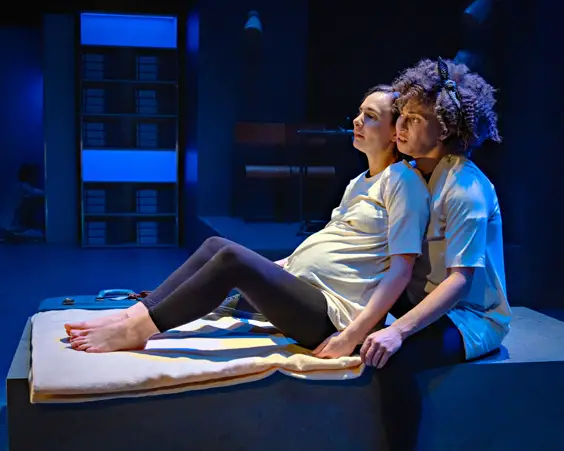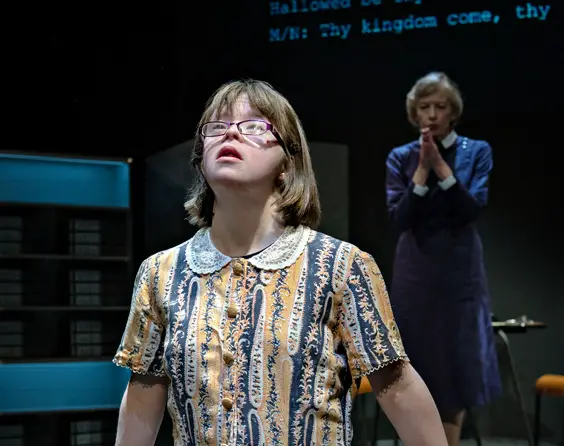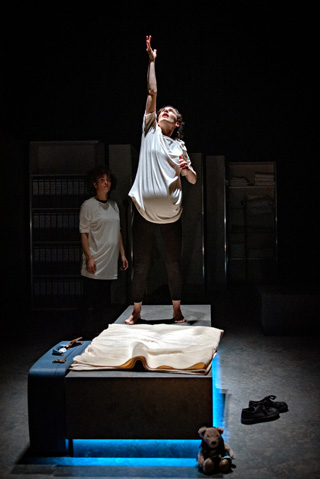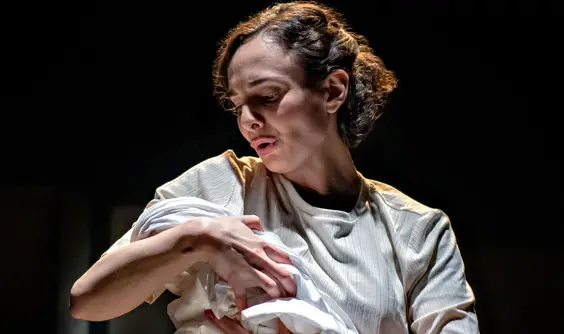Be My Baby – Review – Leeds Playhouse
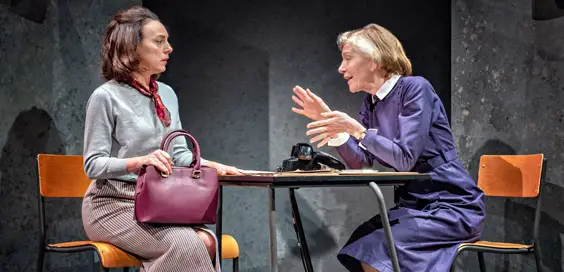
By Eve Luddington, May 2019
The ‘swinging ‘60s’ weren’t all flower power and sexual liberation. Be My Baby is a sharp reminder of that. The action takes place over several weeks in 1964, in St. Saviours maternity home where young unmarried mothers-to-be are hidden away and put to work in the laundry or kitchen, under Matron’s eagle eye. Their newborn babies are almost always taken away for adoption; the young women have little or no say in the matter.
In recent years, this practice has been widely exposed (notably in The Magdalene Sisters movie, 2002) but, when Amanda Whittington dramatised it in 1997, she was the first to do so. Be My Baby is a gem of a play, using humour and ‘60s pop songs, borne of the young women’s preoccupations, to lighten a dark subject.
It starts with a musical mash of Dusty Springfield’s ‘I Don’t Know What To Do With Myself’, ‘All Things Bright and Beautiful’ and a prayer, pointing up the vast gap between church teachings and the young women’s emotional experience.
“A different light on the subject”
There are six characters, all female: one mother, Matron, and four pregnant young women. They’re all functions of the story, each serving to throw a different light on the subject, but they’re beautifully written and each has a poignant back story which drives their behaviour.
The mothers-to-be are from varied backgrounds; they’d be unlikely to come across each other socially. None has had a coherent sex education.
In their dorms, three of them ‘self-teach’, reading about the mechanics of childbirth in impenetrable medical books and romantic notions of love in magazines. The exception is Queenie, already hard-bitten by the reality of life after childbirth. She just wants to get the whole thing over with as soon as possible.
“Reflection of social prejudices”
It’s Queenie who subjects herself most readily to incarceration and the strict regime at St. Saviours, knowing that the options for those who can’t scrape together the weekly boarding fee may be far worse.
Whittington doesn’t intend us to regard this particular ‘home’ as brutal; rather as an institutional reflection of social prejudices. Matron is briskly pragmatic but has compassion.
This production is the last in Leeds Playhouse’s exciting Pop-Up season. It’s presented in association with Mind the Gap, a Bradford-based company which, for 30 years, has been one of Europe’s leading learning-disability theatre companies. Be My Baby is well-chosen; shockingly, 90% of children born to women with learning disabilities are still removed from their mothers.
“Works brilliantly”
Amanda Stoodley’s set shows there’s nothing homely about this maternity home: it manifests sterility. Matron’s featureless grey office on a podium at the back is almost like Big Brother, watching over all. There’s a place for everything and everything in its place. On each side of the office are lofty grey storage shelves, stocked with ironed bedding or box files. The dormitory beds are grey boxes. A large mounted screen displays a case-number as the play begins, then captions the entire performance. (Thank you, Leeds Playhouse: it’s just the job for people with hearing difficulties!). Fittingly, the boxes sometimes obstruct the movement of the girls, pointing up the stark contrast between the girls’ vitality and their inhibiting surroundings.
The last production I saw of this play – at Bradford Playhouse – was entirely naturalistic. This is not. Director Jacqui Honess-Martin has made some imaginative choices. The actors belt out the musical numbers themselves rather than relying on recordings. This idea works brilliantly to demonstrate that the characters have voices, even if they’re repressed. The freeze-frames also have impact, capturing moments of work, leisure, strong emotion, like photos in the background.
“Physical distance”
Overall, I was less enthusiastic about the movement technique (Viewpoints) used by Honess-Martin and Movement Director, Jenni Jackson, to physicalise and dynamise relationships between the characters and with the space. In the first scene it highlights very effectively all the inhumanity we gather from the set, as Matron ‘welcomes’ middle-class Mary and her mother to St Saviours. All the talk is about Mary but hardly ever with her. The older women sit in the office while Mary perches on a box near the audience, looking our way. The physical distance between the characters speaks volumes: we feel for Mary and, like her, are alienated from the action.
But, more often than not, the movement patterns were distractions for me, as were the moments when actors came out of character for no apparent reason. Imaginative concepts don’t always work for an audience.
The female members of Leeds Playhouse’s Pop-Up ensemble demonstrate the high acting standards that can be achieved when a company works together for a year.
They’re joined for Be My Baby by Anna Gray, from Mind the Gap who looks very much at home with the team. She gives an assured and poignant portrayal of Norma who’s so unhinged when her baby is taken away that she searches in cupboards for him.
Tessa Parr brings a delicate, wide-eyed pathos to Dolores, the quiet lass whose trusting nature has had ghastly consequences and whose faith in her (married) ‘knight in shining armour’ will, of course, be dashed.
“Underlying empathy”
Only one of the young characters’ mothers appears – 19 year-old Mary’s. There’s palpable tension in Jo Mousley’s Mrs. Adams, a nervy woman so conscious of family reputation, so terrified of stigma – and so over-protective and buttoned-up with her daughter that she can’t bring herself to talk to her about the newborn baby.
Mary herself has the social graces of a well-off, well-educated and bright young woman. Simona Bitmate captures a character caught in an uncomfortable stage between blissful innocence and worldly knowledge: mature in many ways, she has no idea of motherhood and can’t imagine its drawbacks.
The climax of the play and a highlight of this production is the scene in which Mary is persuaded by Queenie to part with her newborn baby.
Crystal Condie is brilliant as the feisty cynic, Queenie. She’s all sharp edges and tough exterior which make her momentary flight of fantasy and her underlying empathy all the more touching. Condie shows us that this character has evolved from harsh personal experiences.
“Contemporary resonance”
Susan Twist as Matron gives a beautifully balanced performance, revealing a woman who treads a fine line between professional briskness and deep sympathy with those in her charge. Her character’s story could seem sentimental in less talented hands. Twist silently creates another highlight of the show as she sits in sad contemplation of her own lost love, listening to the words of ‘Anyone Who Had a Heart’.
I was delighted to see that Leeds Playhouse’s community efforts have really paid off during their Pop-up season, bringing in audiences who may not otherwise consider a theatre trip. Lots of girls and young women attended Be My Baby. Perhaps they viewed the 55 year-old play as a fragment of social history (it’s on GCSE syllabuses).
Valid as that reading would be, there’s contemporary resonance too.
The progress made in women’s rights to since the 1960s was fought hard for and, even now, social acceptance of unmarried mothers and their children is by no means universal. Judging by the regressive measures adopted since Trump presided in the USA, women’s rights will never be a ‘given’.
images: Anthony Robling

